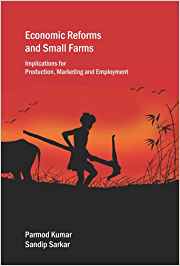The prolonged agrarian crisis in India since the mid-nineties is reflected by the meager growth rates in the agricultural sector. Even during the high growth period that the country experienced in 2004-8, the agricultural sector remained unresponsive in terms of growth except for a rare year of buoyant growth. However, the dimensions of the agrarian crisis cannot be captured by growth rates alone but also through other macro-indicators like use of inputs, availability of irrigation and power for cultivation and, more importantly, the income and consumption levels of farmer (and other rural) households. It is not only for this purpose that micro-level household surveys are necessary but the latter also help in comprehending the vastly diverse production conditions under which the farmers from different regions in India are operating. In that context, Economic Reforms and Small Farms is a useful and detailed attempt to engage with the diversity and challenges before Indian agriculture.
The authors try to identify the broad contours of the agrarian crisis and pose questions related to the remedial policies that are required to revive Indian agriculture. Within this exercise, they however, lay their primary emphasis on the diverse production conditions for farmers within different States.

